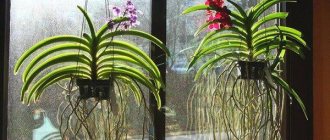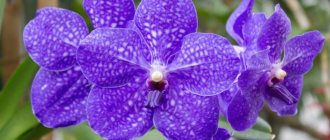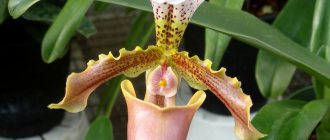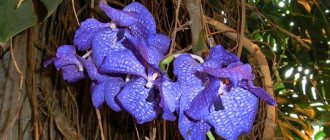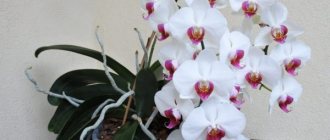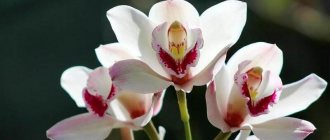The Vanda orchid has recently become one of the most popular epiphytes grown at home.
According to the type of growth, the Vanda orchid is a monopodial orchid: it has one vertically growing stem and one apical growth point. The plant surprises with its numerous powerful, well-developed aerial roots, capable of growing about 1 m in length. The Vanda orchid is grown in glass vases, flasks, hanging baskets - a bunch of bare roots is an interesting sight.
The stem of this orchid is cylindrical in shape, reaches a height of just over 1 m, it is completely covered with leaves located in the same plane. The leaf blades are cylindrical (rolled) or belt-shaped, leathery, 0.7-1 m long, 25-30 cm wide, they are green, and may have a bluish tint. With proper care, the Vanda orchid grows one leaf within 1.5-2 months.
When does the Vanda orchid bloom?
Vanda orchid in a flask care and cultivation photo
Depending on the variety, the Vanda orchid blooms in the autumn or winter months.
Flower buds are laid in the axils of the leaves, the flowering stem can be straight or drooping, the length is 30-60 cm. The racemose inflorescence bears 2-15 flowers with a diameter of up to 10 cm. Even after blooming, the corollas continue to grow for several days, not only increasing in size , but also acquiring a brighter shade. A blue, red-violet or pinkish tint is laid out in a mosaic pattern, which gives originality and special attractiveness.
The lifespan of the Vanda orchid is about 30 years. It is notable for the fact that it does not have a dormant period; the growth rate of leaves stops only during flowering.
The plant was discovered and described by William Johnson in 1795 during a trip to India. The natural habitat of the Vanda orchid is India, China, and Thailand. There are about 53 plant species, which served as the basis for the development of many varieties. Representatives of the genus Vanda successfully cross with Ascocentrums (they have more compact sizes), many interspecific hybrids have been bred, and work is underway to create a miniature orchid.
Compared to other epiphytes, the Vanda orchid is less demanding to care for.
Description
These orchids are perennial herbaceous plants that grow in humid tropical locations.
The flower has the following external characteristics:
- Flowers can vary in shape and color. Located on a non-branching stem. The color can be plain or speckled.
- The petals of the flower are located as if in one plane.
- The stem is cylindrical, the flowers on it are arranged in two rows.
- The leaves are fleshy or not very fleshy, have a belt-shaped and ovate shape, and an intense or bluish-green color. The thickness of the leaves is due to the storage of water in them. Depending on the variety, they reach a length from 25-30 cm to 70.
- Due to its growth on rocks or host plants, the species has aerial roots (up to 1 m) of silver-gray color.
- The inflorescence is a raceme. Over the course of a couple of days, the blooming flowers still gain brightness and continue to grow.
If the aerial roots are damaged, the plant will die.
Cut Vandas can remain fresh for up to 2 weeks.
What is the difference from other types?
A huge variety of different types of orchids grow in almost every apartment around the world. The Vanda orchid differs from the “rest” in its remarkable aerial roots , which are capable of absorbing water not from the substrate, but directly from the air.
They are also exceptional for their attractive appearance, decorating any bouquet or interior.
Ways to grow Vanda orchid
The plant leads an epiphytic lifestyle and can be grown in three ways:
Using a substrate - growing in a pot
Growing vanda orchid in a pot with substrate photo
Use a plastic pot that is loose enough so that the roots are not crowded. It is desirable that the container be transparent. Make plenty of holes to provide ventilation. The substrate for growing orchids can be purchased at a flower shop or prepared yourself. To do this, take 2 parts of pine bark, 1 part each of perlite and foam chips, ½ part peat, add pieces of charcoal.
Growing Vanda orchid in a glass vase
Vanda orchid how to care at home photo
You will need a stable but not too tall vase or flask. Only the rhizome should fit into the container, and the green part should be outside (the plant needs bright light, and glass blocks access to sunlight, plus there is a risk of leaf rotting). The shape of the vase can be varied: oblong, spherical, goblet, etc. It looks very impressive, the Vanda orchid in a glass vessel is a great idea for a gift.
Watering Vanda in a glass vase is very simple: carefully pour water along the walls so that the roots are in the water, and after half an hour, carefully tilt the vase and drain all the water, making sure that no moisture remains. In summer, when it’s hot, water it 2 times a week; on cool days, once a week is enough.
This method of growing has its drawbacks: the glass gradually becomes cloudy and dirty, the vase must be constantly washed, and it is inconvenient to remove the orchid, especially if the roots are tightly “grown” to the wall of the vase and are damaged when trying to remove them.
Tricks for growing Vanda orchid in a glass vase
The Vanda orchid, grown in a glass vase, is a stylish interior decoration.
Take care of the comfort of the plant:
- choose a container with a wide base;
- the plant will live longer if the green part is outside the glass container;
- when growing in a glass container, no substrate is needed;
- Keep the roots dry in the container. To water or feed the plant, it is better to take out the orchid, immerse it in ordinary water or a fertilizer solution, let the water drain well and dry the roots, then return it to the vase. This method is better because the vase remains clean and is easier to wash than if you water the plant in a vase and then drain the water.
Growing Vanda orchid in hanging baskets with bare root system
Growing Vanda orchid with an open root system photo
You can grow vanda in hanging baskets or pots with large side holes through which the roots will freely penetrate outward. Water such plants under a warm shower, allowing them to dry and thoroughly blotting off excess water in the axils of the leaves. Watering can be replaced with conventional spraying from a spray bottle. On hot days you need to spray daily, on cool days - once every 2-4 days.
Home care
All orchids, and Vandas are no exception, need good care, and if you decide to grow them at home, you will have to work hard to create these very conditions; they are incredibly demanding to keep and require a lot of attention. Vanda is often called the queen of orchids and her care is also royal.
These plants do not have a dormant period; they belong to evergreen orchids and can bloom almost all year round, more abundantly in the spring and summer. After flowering, the flower stalks need to be cut off. The temperature for Vanda should not be below twenty degrees (otherwise the plant loses its ability to resist diseases), and they feel best at twenty-five degrees.
There should be a lot of lighting for this type of orchid (but not under the scorching sun). If there is little light, the orchid will not bloom, and if there is a large deficit of sun, then Wanda will get sick. The duration of daylight for this orchid should be twelve hours (which is quite difficult to organize at home).
The humidity in the room where Vandas grow should be at least seventy percent and no more than ninety percent, which can be maintained at home only with the help of a humidifier. Spraying orchids in dry, cool air or at night is harmful to these plants and leads to the development of diseases. Changes in humidity are very dangerous for this plant, so the orchid must be protected from this phenomenon.
Another important condition for Vanda’s well-being will be sufficient air circulation, since the plant must be well ventilated, otherwise this will lead to rotting of the neck. At home, you can install a fan next to the plants for this.
The Vanda orchid needs additional feeding, which is using complex fertilizers (once a week and only in the morning), and washing (every few months with a lemon solution in the ratio of one teaspoon of freshly squeezed juice per one liter of water at a temperature slightly above room temperature ). You can increase fertilizing during flowering, but if the plant is sick, then on the contrary, fertilizing will only cause harm.
Watering the Vanda orchid should be plentiful, but careful. You need to water in the morning, and in the summer take a morning bath (place the plant in water for a third of an hour until the root system acquires a green tint). In autumn, water only when there is sunlight, otherwise the plant is watered every few days. In winter, you can water the plant only after the substrate has completely dried.
The health of a flower depends on proper care for it.
These orchids are replanted as they grow from the pot (approximately every three years). They don’t take large pots for Wanda, because in such spaces she slows down her growth. It grows in a specialized mixture, which is bought in flower shops (you can prepare it yourself, but it’s unlikely to be cheaper or of better quality). There is no need to trim the Vada (only if the stems have become too tall, you can cut off the top part and replant it in the substrate).
As a container for the Vanda orchid, you can use hanging baskets, pots with side holes or a vase. If you grow Vanda in a vase, then there should be no water in it; in this case, the plant must sometimes be taken out and dipped in water with fertilizer, dried and moved back. Although you can simply pour water into a vase and wait until air bubbles stop coming out, indicating the need for liquid. When the orchid “gets drunk,” the water is poured out of the vase. If the orchid is constantly in water, then it begins to rot, and if the container is closed, then the plant will die altogether. It is ideal when the vase has a wide base and the green shoots are located outside it. Hanging baskets are convenient because they give “freedom” to roots, which can reach a length of more than a meter.
Conditions for growing Vanda orchids
The Vanda orchid is light- and heat-loving; the most suitable place for its placement would be windows facing east and west.
Air temperature
During the spring-summer period, maintain the air temperature at 22-25 ° C (the plant can tolerate temperature increases up to +28 ° C). To stimulate flowering at night, lower the air temperature by about 10 °C. In winter, dry maintenance with an air temperature of 14-16 ° C will be required. With strict adherence to the rules of care (watering, air humidification, ventilation), the Vanda orchid grows and develops well. When ventilating, do not allow a draft; in the summer season you can move it to fresh air (on the balcony, in the garden, in the gazebo).
Lighting
The plant is demanding in terms of lighting: all year round, the duration of daylight hours should be 12 hours a day. Lighting must be diffused; direct sunlight will cause burns on the leaf blades. In the autumn-winter period, additional artificial lighting will be required. Use regular fluorescent lamps.
The level of illumination is indicated by the size and shade of the leaves. They should be a normal green color and almost the same size. If the shade of the leaf blades is dark green, there is not enough lighting; if it is pale green, yellowish, the lighting is intense. If the last pair of leaves grows longer than the penultimate one, the lighting level needs to be increased, and when it’s the other way around (the penultimate pair is longer), the lighting level should be reduced.
Typical diseases
The orchid is practically not susceptible to pest attacks. Occasionally, aphids, spider mites or mealybugs can be found on plants. Fusarium is a common disease. The main symptom is brown spots at the base of the leaf. Treatment is spraying with Fundazol. Often we have to deal with bacterial rot. The only salvation is to remove the affected areas and treat them with fungicides. Other problems are related to violation of care rules.
| The leaves wither, wrinkle, and rot at the base. | Excess water. | Watering and spraying are temporarily stopped. If the flower is grown in a substrate, it is recommended to transplant it into a new dry substrate. |
| Yellowing of leaves. | Possible causes are lack of moisture, heat, exposure to direct sunlight. | Negative factors must be eliminated. |
| Lack of flowering. | There are no differences in daily temperatures. Little light. | They organize artificial lighting and take it out to the balcony at night in the summer. |
| Falling flowers. | Possible causes are lack or excess of moisture, pest damage. | It is recommended to normalize the watering regime and carry out preventive treatment with fungicides. |
Despite the fact that the Vanda orchid is a capricious plant, many people grow it. The efforts made are fully repaid by the beautiful, long-lasting flowering, unusual, decorative appearance.
How to care for a Vanda orchid
The Vanda orchid is sensitive to water conditions. During the period of active growth (spring-summer), the substrate should be constantly slightly moist. In winter, water moderately; in cold conditions, watering is minimal (water when the substrate is completely dry).
Alternate wet and dry cycles to avoid causing root rot. In summer, when it is very hot, water almost every day; in winter, when it is warm, water every 2 days (it is better to water before lunch).
There are several ways to water a Vanda orchid:
A warm shower is the most suitable watering option for Wanda. Place the plant in the bathtub and run it with very warm water from the shower until the roots turn green. Then leave the plant for 30 minutes to allow the water to drain. After an hour, wipe the leaf plates with a soft cloth.
Immersion - a pot with a plant is placed in a container filled with water for 30 seconds. Let the liquid drain. In this way, only completely healthy plants are watered.
Soaking - the orchid’s roots are immersed in a container of water and left to “drink” for half an hour to several hours. So water it 2 times a week.
Watering can - add water by moving along the edge of the pot. Pour water until it begins to appear in the pan, drain off excess water.
The optimal indicator of air humidity when growing Vanda is 70%. Regularly spray the aerial roots of the plant, do not allow water to get into the axils of the leaves.
The most common types
Briefly but succinctly, we suggest that you familiarize yourself with the widespread types of house flowers. You can easily find the specimens listed below on the shelves of the nearest flower shops or in the flower nurseries of the large army of lovers of this exotic plant.
You can learn about rare and unusual varieties of orchids here, and read about the largest orchid in this material.
Phalaenopsis - growing features
Phalaenopsis is considered the most common species grown indoors. The plant is quite light- and heat-loving, and this must be taken into account when choosing its location.
With the exception of the autumn period, when phalaenopis is at rest, the air temperature around it should be at least +18 degrees.
Like other species, it prefers soft, diffused light, but it also does well away from the window, in the presence of artificial lighting.
An important condition for development and growth: proper watering and absence of drafts. It prefers fine spraying, and care must be taken that the water does not touch the flowers. You can simply wipe the phalaenopsis leaves regularly with a damp cloth.
You can simply wipe the phalaenopsis leaves regularly with a damp cloth.
It prefers fine spraying, and care must be taken that the water does not touch the flowers. You can simply wipe the phalaenopsis leaves regularly with a damp cloth.
It is best to water them with warm water, which has previously undergone a process of cleaning and settling.
This can be done in two ways:
- giving the plant “Tropical Rain” for 5-10 minutes;
- placing the pot with the plant in water for a short time.
During the period of intensive growth and flowering, the phalaenopsis orchid needs to be fed. But it is also necessary to remember that its excess amount leads to cracking of its leaves.
To speed up the flowering process, the plant should be placed in a cooler place, reducing its watering to a minimum. At the same time, you should not allow the substrate to dry out, periodically spraying it.
Optimal conditions for flowering: room temperature from +18 to +25 degrees, sufficient light and moisture. In such conditions, phalaenopsis can bloom for up to six months.
How to properly care for Vanda?
Like other types of orchids, Vanda cannot be called a flower that is easy and unpretentious to care for, especially when they are grown in glass.
As a rule, plants of this type are sold in baskets in which there is almost no substrate. In addition, you can also use wire pots and nets to grow them.
A distinctive feature of Wanda is their high demands on light, as well as on temperature conditions, which should fluctuate between +22-25 degrees, with indoor air humidity 70-80%.
Watering the plant during its vegetative activity should be done every 2-3 days. At the same time, the flower is fed once every two weeks.
During the dormant period, do not water or feed.
To maintain optimal air humidity when growing Vanda orchids, you can use special air humidifiers or containers filled with water.
Dwarf species
Dwarf orchids occupy an equally worthy place among their taller and more noticeable “compatriots”, enjoying the well-deserved love of many gardeners.
Caring for such a plant is quite simple:
- It is best to grow in a transparent pot, placing it in a place away from direct and bright sunlight. The optimal choice would be the east or west windows of your apartment;
- in addition, water it once a week by immersing it in warm water for 15-20 minutes;
- Fertilizer must be added to the “bathing water” once every two weeks.
There is no need to spray dwarf orchids; it is best to periodically wipe them with a slightly damp cloth. If you do everything correctly, your “pets” will delight you with their luxurious flowers at least twice a year.
Popular articles Ringed cap mushroom, descriptionInteresting video about caring for Vanda orchids:
How to feed Wanda
The Vanda orchid is very fond of feeding, and it needs to be fed throughout the active growing season. Use special formulations for orchids, but dilute them with more water, 2-3 times the recommended dose. You can feed by mixing fertilizers into the water for irrigation or spraying the leaves with the solution. Fertilize every week while the orchid's roots are growing. During the dormant period, feeding is stopped.
Lack of nutrients leads to poor flowering. But you shouldn’t be too zealous with fertilizing: the plant will become elongated, the top will soften, and will bend under the weight of the inflorescences. Pay attention to the young leaves: on their surface there is a stripe of a pale green hue, normally its width is a centimeter. If the strip is narrower, there is not enough fertilizer; if it is wider (up to 2 cm), there is an excess of nutrients.
Features of care
This type of orchid is exotic for our latitudes, so caring for vanda and growing it in a climate unusual for the plant will require significant effort from you. Let's get acquainted with a number of important features of the vanda orchid:
- the evergreen orchid does not have a pronounced dormant period;
- a guest from the tropics is very demanding in terms of living conditions, and without knowledge of how to care for Vanda, you will not achieve success;
- Vanda, even next to other orchids, is strange and exotic because of its long, tangled, hanging roots, and you will have to place it in a place where it will be comfortable and you can regulate the microclimate.
When to replant a Vanda orchid
Replanting Vanda after purchasing photo of the root system in the substrate
Replanting is carried out immediately after purchase, and also as necessary, when the roots no longer fit in the pot or the growth rate of the Orchid slows down. In general, transplantation has to be done once every 3-4 years.
Emergency transplant cases:
- The substrate is compacted (poor air and water permeability, takes a long time to dry);
- The plant was initially planted in an unsuitable substrate;
- The roots are too deep into the substrate;
- Root system rotting.
Features of propagation and transplantation
Every gardener needs to know the features of propagation and transplantation. The need for transplantation occurs every two to three years. The plant does not need to be replanted more often, and it should not be touched unless necessary, since vanda, like any other orchid, reacts negatively to disturbances in its tranquility. The need for a transplant is indicated by:
- caked, contaminated, damp substrate (it does not allow air to pass through, does not retain water well and takes a long time to dry);
- the presence of rot on the root system;
- excessive depth of the root system into the soil;
- The plant does not fit in the pot.
If you notice any of these factors, it's time to start replanting. You need to prepare fresh substrate and a new larger pot. Then proceed like this:
- Carefully remove the plant from the pot.
- Immerse the root system in warm (4-5 degrees warmer than room) water and soak for twenty minutes.
- Remove any remaining substrate and inspect the roots. If you see rotten or dried roots, they need to be cut off, the cut areas should be treated with ground cinnamon or crushed activated carbon and dried.
- Next, take a pot and cover the bottom with a drainage layer two centimeters thick (expanded clay is excellent), then add a little bark and install a vand. Holding it with your hand, sprinkle with the remaining substrate, but not tightly so that the roots can breathe. Sphagnum moss is laid on top.
- You can water the plant two to three days after transplanting.
Vanda propagation is carried out by transplanting its children. They can form in any part of the plant, but this variety is characterized by their appearance on the roots. It is necessary to separate the children only after the roots have reached at least five centimeters in length. The baby is cut off with a disinfected sharp knife, and the cut areas are treated with ground charcoal, which helps to avoid infection.
The baby needs to be placed in a separate pot with a small amount of substrate. Moreover, the ratio of tree bark and sphagnum moss should be 4:1, respectively
It is important to maintain a temperature of 26-27 degrees and a humidity of about 90% until the roots grow to a length of 20 centimeters. It is most convenient to do this in a greenhouse.
Next, the baby is transplanted into an ordinary pot and cared for as an adult plant.
All other methods of reproduction are not available for Vanda. Some gardeners strive to grow an orchid from a seed, but this is quite difficult and time-consuming. In particular, greenhouse conditions will be needed (temperature about 28-29 degrees constantly, humidity above 90% and illumination for at least 12-15 hours a day). You will have to wait at least nine months for the sprout to appear from the seed. Next, the shoot will grow for three years, and only then can it be transplanted. You will have to wait another four to ten years before the first flowers appear, even if you know all the secrets of keeping and caring for an orchid.
Reproduction of Vanda orchid by children
Seed propagation of the Vanda orchid is used mainly by breeders.
In home floriculture, Vanda is propagated vegetatively.
Babies form at the base of the stem. Also, lateral shoots appear in the leaf axils. They can be separated when they reach a height of at least 5 cm and have at least one root. Carefully separate the sprout and treat the cut area with a fungicide. For rooting, plant in a small pot with a universal substrate for growing orchids, cover with a jar or cut-off plastic bottle on top - it is important to maintain air humidity of at least 85%. After 14-20 days, gradually accustom him to room conditions. When the plant reaches a height of 20 cm, it can be transplanted into a container for continuous growth.
When the orchid becomes very long (tall), its top can be used for rooting. Cut off the top, treat it with a growth stimulant and plant it in the soil for rooting, creating a greenhouse effect.
Over time, the lower part will also give birth to “babies”.
Reproduction methods
Growing the Vanda orchid involves two main methods, however, at home, gardeners prefer to use the most accessible and effective - lateral shoots (or children).
By division
If aerial roots form on the top of the Vanda orchid, then it is carefully trimmed, planted in a container with special soil for these flowers and placed in a warm, humid place (you can build a greenhouse), avoiding direct sunlight. The work is carried out with a previously disinfected instrument, the cut site is treated with crushed activated carbon.
The young plant is not watered, only sprayed until it takes root well and begins to grow. After this, you can care for it using standard methods.
Diseases and pests of the Vanda orchid
Spots on Vanda orchid photo
The Vanda orchid is susceptible to various diseases, the causes and signs of damage, control methods are described below.
Fungal infections
Fungal infection on Vanda orchid photo
Treating plants with Physan according to the instructions helps against fungal infections (as in the photo above).
Spotting - spots similar to warts form on the underside of leaf blades. This happens from waterlogging of the soil or high air humidity.
Fusarium - round black spots appear at the base of the leaves. The reason is that the environment is too warm and humid.
How to treat spots on a Vanda orchid
Black spots on Vanda orchid photo
Treat the leaves and roots with a fungicide, provide shade, do not spray the orchid on the leaves, reduce air humidity, avoid too high and too low temperatures (it is advisable to maintain 24°C).
Bacterial rot
Overmoistening of the substrate (especially in combination with low air temperatures) causes rotting of the root system and stem. The roots of the plant soften and turn black, the stem turns yellow, without intervention the plant will die. Carry out an emergency transplant: cut off the affected areas, treat the entire plant and cut areas with a fungicide (phytosporin, Bordeaux mixture), replace the substrate with a new one, also disinfect the container, keep the orchid in the shade until it shows signs of growth. Treatment with an antibiotic helps against bacterial rot (1 gram of tetracycline is dissolved per liter of water).
As a last resort, you have to cut off the rhizome completely. It takes some effort to grow the root system again. Be sure to treat the cut area with crushed charcoal. The ideal option for resuscitation is to place it in a basket made of natural raw materials with large weaving. Maintain a high level of air humidity and water by spraying. Under such conditions, young roots will appear after 7-10 days.
Viral lesions
Infection by various viruses is especially dangerous. Viruses do not spread as quickly as bacterial or fungal rots, but they are almost impossible to cure. If you decide, it is better to get rid of the diseased plant so as not to infect all the orchids. The virus can be kept dormant: cut off all affected parts, treat the orchid with a fungicide. Avoid elevated temperatures and excessive humidity. Remember that viruses are most aggressive during the warm season.
How to treat an orchid against thrips and mites video:
Among the pests that can cause trouble:
- Thrips
Light dots and streaks appear on the surface of the leaf blades, over time they become covered with a whitish coating, then turn brown and die. Thrips and flowers are affected: they become covered with spots and become deformed.
- Shields
Yellowish dots appear on the leaves and stem, which over time take on the appearance of warty growths. Scale insects suck the juices from the plant, causing the orchid to dry out.
- Mealybug
Small insects collect on the reverse side of the leaf and can be recognized by the presence of a coating similar to cotton wool. The growth rate of the orchid slows down, the leaf blades die off.
- Spider mite
How to deal with mealybugs video:
The pest attacks the plant when the indoor air is dry. Thin whitish cobwebs can be found on the plant. The pest settles on the reverse side of leaf blades. The leaf blades turn yellow and dry out.
If any pests are detected, they must be removed mechanically. To do this, moisten a cotton pad with soapy water and wipe the leaf blades on both sides, then treat with an insecticidal preparation.
Location and lighting
Vandas are very light-loving orchids. She needs about 55,000 Lux. Only southern windows can provide such sun throughout the year. But in spring and summer, our aggressive sun produces up to 70,000 Lux, and this already threatens with serious burns, even the death of the orchid. Therefore, during this period, Vanda on the southern windows must be shaded.
You can tell when a plant gets a lot of light by the freckles that appear on the leaves.
South-eastern, western and south-western windows are softer in relation to the sun. But in winter, there may not be enough light for the vanda orchid, so you need to monitor the tips of the roots: if they grow, then there is enough light.
If there are only northern, northwestern or eastern windows in the room, then Vanda will grow very slowly there and will never bloom. You can get out of this situation with powerful additional lighting.
When keeping Wanda in an apartment, no matter what window she grows on, in winter she must be given additional light so that there is at least 12 hours of daylight.
Varieties of Vanda orchid
Among the variety of species and varieties, only a few are grown indoors. Let's look at the best of them.
Blue Vanda Vanda coerulea
Vanda blue Vanda coerulea photo
Discovered in 1837 in the tropics at an altitude of 1000 m above sea level. The length of the strong, erect stem is 0.8-1 m; often the base of the stem is exposed. The leaf blades are hard, dark green, 12-18 cm long, about 3 cm wide. The leaves are located opposite. The lateral inflorescences are 30-60 cm long and bear 14-20 large corollas. The color scheme is lavender-blue, the shade can be lighter or darker. Most often, the first buds bloom in August, the flowering period ends in December-November.
Vanda Sanderiana Vanda sanderiana
Vanda Sanderiana Vanda sanderiana photo
Originally from the warm rainy tropics. The racemose inflorescence consists of flowers with a diameter of 10-15 cm. The sepals are greenish-yellow in color; chestnut veins may be present. The color of the petals is white, pinkish, yellow.
Vanda tricolor
Vanda tricolor photo
The plant can reach a height of 1.5 m. The flowering stem is short and bears about 10 corollas. Petals and calyxes are egg-shaped with wavy edges, the nail is wide. The lip is three-lobed: the central lobe is larger, guitar-shaped, pink or purple, the remaining lobes are spotted.
Vanda Rothschildiana Vanda rothschildiana
Vanda Rothschildiana photo
Less demanding in care. The color range of inflorescences includes pinkish and blue shades. The flowering period is from March to October.
Air humidity
Air humidity in the life of a vanda orchid is not intended to saturate the roots with moisture. It regulates the connection of leaf plates with the environment. It is necessary to increase air humidity in the area of the leaves, not the roots.
An orchid can benefit from 70% humidity in the crown area, as it will force the stomata to open during the day, transforming the process of photosynthesis to a different quality.
If you increase the humidity of the root system to 70%, and 40% remains around the leaves, there will be no acceleration in plant growth.
Solving possible problems
An orchid will not hurt if you care for it properly. All diseases are due to lack of light or abundant watering. An orchid growing in good light conditions protects itself from infections and produces the necessary antibodies.
Care errors
Improper maintenance of a flower can lead to a number of problems. If you notice the damage in time, the orchid can be saved.
Root rotting
If the roots of an orchid are in contact with water for a long time, they begin to rot. In this case, you need to reduce watering. It is advisable to inspect the plant itself, cut off all rotten parts, and treat the wounds with activated carbon or sulfur. Typically, the roots rot in orchids growing in substrate. In this case, you need to treat the roots and transplant the plant itself into a fresh substrate. After transplantation, the plant is not watered for 3-5 days.
Falling buds
Buds drop if the plant lacks sun, moisture or nutrients. Another cause of this problem can be insect pests. It is necessary to give the flower a warm shower, feed it with potassium and phosphorus, and place it on the windowsill. Pests are eliminated mechanically (insects are collected with a damp swab) or by spraying with an insecticidal solution.
Yellowness of leaf blades
There are several reasons for this problem. Leaves may turn yellow from too much sunlight or lack of moisture and nutrients. Yellowing of leaf blades can cause a fungal disease. The orchid needs to be carefully examined, the roots should be immersed in a basin with a nutrient solution for 30 minutes, and placed in a shaded place.
Brown spots on leaves
Leaf spots can appear due to nutrient deficiency, fungal infection or sunburn. The roots of the orchid need to be examined; healthy ones should be immersed in a basin of water, adding potassium-phosphorus fertilizer. Then it is advisable to place the flowerpot in a shaded place for several days.
The plant droops
Typically, this problem occurs due to fungal infection, lack of light, lack of nutrition and moisture. True, an orchid can droop and become lethargic if there is an excess of nutrients and excessive watering. It is necessary to inspect the plant. A healthy orchid has dense, juicy, greenish roots. Roots affected by infection or overfed with nutrients have a soft, slimy, loose structure. If there is an excess of moisture, the roots rot.
No flowering
Vanda should bloom 1-2 times a year. Flowering occurs in spring and summer. If a flower does not bloom for a long time, it needs to be created in a stressful situation, that is, kept warm during the day and taken out into the cold at night. True, the night temperature should not fall below 15 degrees Celsius. The difference between day and night temperatures should be ten degrees. The flower also needs to be fed with potassium and phosphorus.
Diseases
If there is excess moisture, lack of light, or nutrient deficiency, Wanda may get sick. It is better to remove rotting, affected parts of the plant immediately. The remaining organs must be treated with a fungicidal agent.
Fusarium wilt
With this disease, brown, rotting spots appear on the roots or at the base of the leaves. The causes of the disease can be frequent watering, excess nitrogen fertilizing, the presence of peat in the substrate, and soil salinity. The diseased plant must be removed from the pot, cut off all affected parts, lubricate the wounds with iodine, and treat the plant itself with a fungicide (Fundazol, Topsin). Then dry it and transplant it into a new pot.
Chlorosis
A disease that causes yellow spots to appear on leaves. You need to water the orchid with soft, settled water. A diseased plant can be transplanted into a fresh substrate and fed with complex fertilizer (iron must be present).
Root rot
The disease appears when there is excess moisture, lack of light and nutrition. It is recommended to inspect the orchid, clean the roots from rot, treat the wounds with iodine or sprinkle with activated carbon. Transplant the treated plant into a fresh substrate and do not water it for a week.
Pests
An orchid can be attacked by insects, especially if it is outdoors in the summer. Pests are removed manually or insecticides are used against them.
Spider mite
This is a tiny red insect that weaves a web on leaves and flower stalks. Acaricides are used against ticks (Kleschevit, Fitoverm).
Causes of leaf falling
Crassula is a striking specimen of the genus of succulents.
Several fatworts coexist in one pot
Their representatives have their own care characteristics, non-compliance with which leads to leaf fall:
- The money tree does not tolerate excessive watering. Each subsequent moistening of the soil can be done only after the earthen clod has completely dried;
- There are also special requirements for lighting. Bright, direct light can cause burns, causing the Crassula to shed its leaves;
- The cause of leaf fall is depletion of the soil mixture, when the soil is not fertilized or the plant is not transplanted into fresh soil for a long time.
Important. Crassula grows poorly in pots that are too spacious, but containers that become cramped also cause succulent disease.
Where to start forming a tree?
Selection of pot
The diameter of the pot is selected according to the size of the crown: slightly larger than its diameter. As the plant grows, the width of the container needs to be increased. A tree with a voluminous, fleshy crown will become more stable. Ideally, a money tree pot should be wide, heavy and flat. A drainage layer is laid out at the bottom.
Not every pot is suitable for a fat plant. Its root grows close to the soil surface. Therefore, a shallow pot for rooting is suitable. The tap root of a crassula in a deep pot tends downward, and the stem tends upward, while thinning and weakening.
A little history
Nowadays, there are a large number of varieties and species of this plant and innumerable hybrids, with which botanist breeders replenish greenhouses almost every day.
Over the past few decades, trunks have been developed that are distinguished by:
- The height of the plant itself;
- Diameter of flowers;
- Flower color;
- Odoriness;
- Leaf color.
This flower captivated Europeans more than 200 years ago, but difficulties in growing it prevented the orchids from spreading throughout the continent unhindered.
And only after the development of hybrids such as phalaenopsis, the standard began to be grown not only in greenhouses and greenhouses, but also on the windowsills of their own homes.
Nowadays, you can buy a phalaenopsis orchid in every flower shop, but not all varieties are so widespread; there are varieties that require a lot of effort to find.
We will talk about these today.
Tips and secrets of professionals
What to do if the root system is very weak?
You can help the plant grow a lush root system by using root or its analogues according to the instructions.
Ventilation, airing the plant
Although Vanda comes from the tropics, she prefers the air to be fresh. Therefore, it is necessary to periodically ventilate the plant.
It must be placed in the flask so that air can circulate freely and get inside.
The size of the container in which the vanda is contained must be sufficient for the roots to fit freely inside.
Disinfection of containers
Unfortunately, over time, the inside of a glass vase becomes covered with a layer of algae or a coating of salts. Therefore, the flask will have to be washed constantly . You can disinfect it with a weak solution of potassium permanganate. The plant, of course, should be removed from the vase during this procedure.
